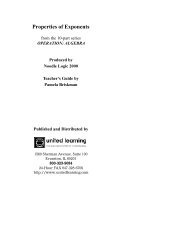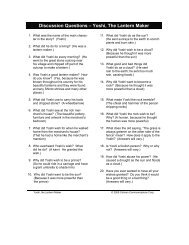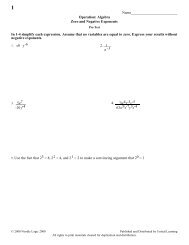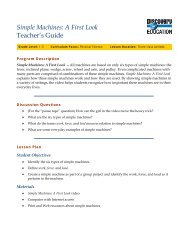Fractional Exponents - Discovery Education
Fractional Exponents - Discovery Education
Fractional Exponents - Discovery Education
You also want an ePaper? Increase the reach of your titles
YUMPU automatically turns print PDFs into web optimized ePapers that Google loves.
SD School Pre-Algebra<br />
Program 3: Roots and Rational Numbers<br />
QuikNotes<br />
If the same kind of exponent is negative, take the<br />
reciprocal of the base number, and then make the<br />
exponent positive.<br />
a<br />
1<br />
−<br />
n<br />
=<br />
a<br />
1<br />
1<br />
n<br />
=<br />
n<br />
1<br />
a<br />
Student Notes<br />
1<br />
− 1 1 1<br />
3<br />
8 = = =<br />
1 3<br />
8 2<br />
3<br />
8<br />
When given a fractional exponent where the numerator<br />
is not a 1:<br />
1. Raise the base number to the power of the<br />
numerator.<br />
2. Take the root as signaled by the denominator.<br />
3<br />
5<br />
4 = 4 3<br />
5 4 3 5 5<br />
= 64 = 2 2<br />
Irrational numbers are decimals that go on forever and<br />
don’t repeat. An example would be the number pi (ð).<br />
A repeating decimal is a rational number. An example<br />
is the fraction, 1/3. It is equal to 0.3333333…<br />
The repetition of 3 goes on forever.<br />
A terminating decimal is also a rational number.<br />
Rational, irrational, and repeating decimals are all real<br />
numbers.<br />
An inequality is a mathematical expression that is<br />
unbalanced. Statements like 5 is greater than 3, or 4 is<br />
less then 7 are considered inequalities because the two<br />
sides don’t balance.<br />
5 > 3 4 < 7

















